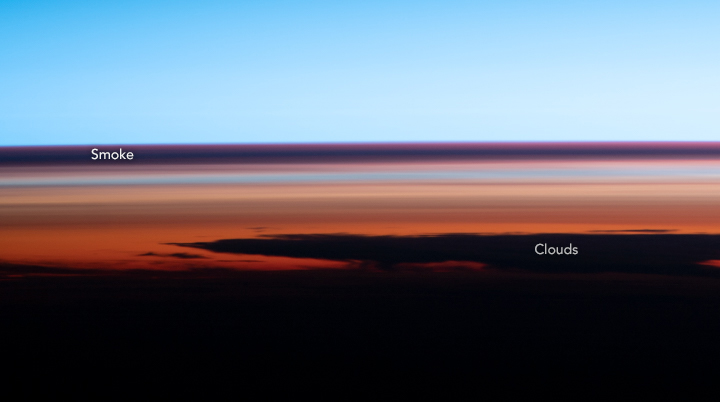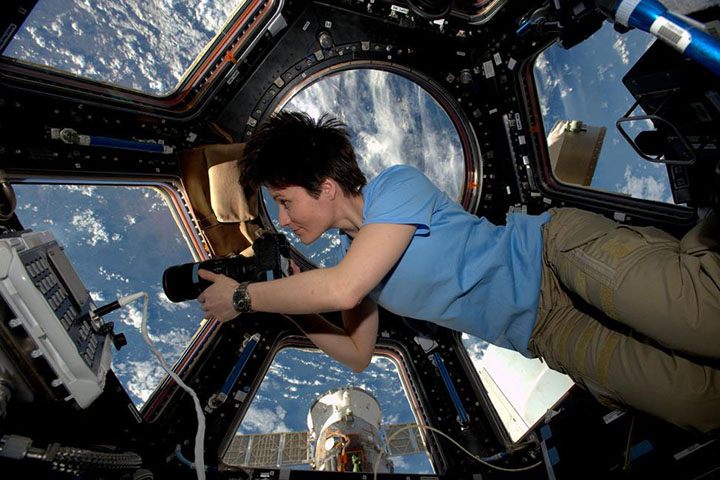

One of the perks of being an astronaut living and working on the International Space Station is the chance to see up to 16 sunrises and sunsets every day. Astronauts occasionally photograph them from the Cupola, the window-filled lookout on the space station's Tranquility module. The dome-shaped structure allows astronauts to look sideways rather than just straight down and easily photograph the edge of the atmosphere and the horizon, which is sometimes called Earth’s limb.
From an average altitude of 400 kilometers (250 miles) above the surface of Earth, the brilliant shades of orange and red along our planet’s curving limb are often stunning. They also showcase an area of considerable scientific interest.
“During sunsets and sunrises, the Sun is close to the horizon, so light has to travel through the atmosphere before reaching the space station,” explained NASA atmospheric scientist Jean-Paul Vernier. “This gives gases and particles opportunities to scatter light in certain parts of the spectrum.”

Astronaut photographs can be especially useful for visualizing aerosols in the stratosphere, a layer of the atmosphere that begins roughly 7 kilometers (4 miles) above the surface near the poles and 20 kilometers above the surface closer to equator. “One of the key things about limb photographs like this is that they can tell us the vertical distribution of aerosol plumes,” said Vernier.
In the photograph above, the presence of small airborne aerosol particles, such as sea salt and dust, has likely colored the air orange in the lower part of the atmosphere over the South Atlantic Ocean on February 12, 2020. Some of the small particles scatter shorter wavelengths (blue and green light) more than other wavelengths, enriching the dimmed light that remains with reds and oranges. Higher up, aerosols are rare and molecules of gas primarily scatter light, making that part of the atmosphere appear blue.
In between, a concentrated smoke layer sits between 23 and 30 kilometers in the stratosphere. The smoke was lofted there by an unusually fierce outbreak of wildfires in Australia in 2019-2020. Several extreme fires built tall pyrocumulus clouds that lofted wildfire smoke higher than scientists have ever observed with satellites. The second image shows a closer view of the smoke plume. The image below shows smoke from the same fires as observed by the CALIPSO satellite on January 23, 2020.
.png)
In the stratosphere, aerosols from fires or volcanic eruptions can function like a shade, reflecting light and resulting in a cooling effect. Vernier is working with NASA’s Crew Earth Observations team, which trains astronauts and develops procedures on how to take photos, of such aerosol plumes so that both scientists and non-specialists can better visualize the role that stratospheric aerosols can have on climate. Their most recent target was the volcanic ash that reached the stratosphere after the eruption of the La Soufrière volcano in April 2021.
While cameras generate some of the most dramatic images from the space station, NASA scientists also have another sensor to study the atmosphere from that platform. The Stratospheric Aerosol and Gas Experiment III (SAGE-III) views Earth’s limb at sunrise and sunset and makes use of a technique called solar occultation to observe ozone, aerosols, and water vapor in the stratosphere. SAGE III was installed on the ISS in 2017, the latest in a line of four instruments flown on satellites since the late 1970s.
“The stratosphere is quite different than the troposphere,” said Vernier. “And astronaut photographers and limb-viewing sensors are well positioned to see it.” One of the most obvious differences is temperature. Unlike in the troposphere, the stratosphere gets warmer with increasing height due to chemical reactions involving ozone. Temperatures in the lowest part of the stratosphere average about -55 degrees Celsius (-67 degrees Fahrenheit) degrees. At the top of the stratosphere, they increase to about -15 °C (5 °F).

Another difference is clouds. While common in the turbulent, moist air of the troposphere clouds are mostly absent from the stratosphere’s dry air. The exceptions are spectacular, including the occasional overshooting tops of thunderstorms poking up from below or the emergence of wispy polar stratospheric clouds.
“While sophisticated instruments exist to study the stratosphere, it is often a gray area for non-experts because of the lack of images that show this layer. Although many people have flown through the stratosphere in an airplane, they don’t have much of a sense of what it is like,” said Vernier. “By having astronauts take pictures of Earth’s horizon at sunset and sunrise, we hope to communicate stratospheric science more easily and demonstrate why instruments that study this layer, such as SAGE III, are so important.”
Astronaut photograph ISS062-E-5419 was acquired on February 12, 2020, with a Nikon D5 digital camera using an 400 millimeter lens and is provided by the ISS Crew Earth Observations Facility and the Earth Science and Remote Sensing Unit, Johnson Space Center. The image was taken by a member of the Expedition 61 crew. The image has been cropped and enhanced to improve contrast, and lens artifacts have been removed. The International Space Station Program supports the laboratory as part of the ISS National Lab to help astronauts take pictures of Earth that will be of the greatest value to scientists and the public, and to make those images freely available on the Internet. Additional images taken by astronauts and cosmonauts can be viewed at the NASA/JSC Gateway to Astronaut Photography of Earth. Cupola photo of Samantha Cristoforetti originally posted by the European Space Agency here. NASA Earth Observatory visualization by Joshua Stevens, using CALIPSO data from NASA/CNES. Story by Adam Voiland.